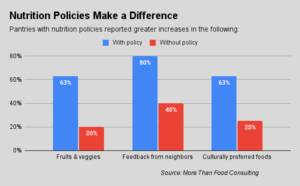It’s fair to say that every food bank in the country would like to prioritize health and nutrition in its policies and procedures. Today, Partnership for a Healthier America is releasing the results of an index it developed to help food banks do just that.
More than two years in the making, the Healthy Hunger Relief Index offers a multi-layered assessment of how well food banks are embedding health and nutrition in their everyday culture and practices. (The full report, including the survey questions plus tips on how to improve along each dimension, can be found here under Resources.)
The aggregated results, taken from 17 food banks, show that the sector as a whole is about two-thirds of the way toward reaching the goals set forth by Partnership for a Healthier America, collectively achieving a score of 1.89 on a scale of zero (no system in place) to three (system is fully in place) (see chart, above). The findings show that food banks are most adept at partnering at the state, local and national level to advocate about health and nutrition (2.18). They are least adept at nurturing an internal culture around health and nutrition through employee engagement and environmental nudges (1.51).

But that holistic view is not really the point of the index, say officials at Partnership for a Healthier America and participating food banks. Really the point is for individual food banks to track their own progress in health and nutrition year over year, rather than compare themselves to the group results. “It’s about seeing where you are on the path, and where you can go in the future, and here are some tips for getting there,” said Michael G. Waddle, Senior Director at Partnership for a Healthier America.
Food banks are enthusiastic about how the index can help them. “We recognize the beauty of the index as being a really great tool for moving us forward,” said Courtney Kennedy, Nutrition and Education Manager at Good Shepherd Food Bank in Maine. “We can celebrate the areas where we’re doing really well and there are pieces of the index where we can build out a strategy for the future.”
The index asks nearly 40 questions within five categories, all intended to draw out how well nutrition and health have been baked into a food bank’s culture and operations. For example, under the category of sourcing, it wants to know if the food bank has a policy that restricts sourcing of unhealthy food. Under agency support, it asks if there is a healthy pantry program. Under leadership, it wants to know if there are any nutrition experts on staff.
Food banks get the most out of the survey when a majority of their employees take it. Doing so exposes gaps in institutional knowledge (the accounting department may not know, for example, that nutrition-ranking is happening in the warehouse). It also gets a wide swath of employees thinking about all the factors that contribute to healthy hunger relief. “I’m so excited about the opportunity for us to engage in deeper conversations,” Kennedy noted.
Good Shepherd Food Bank, which has been working toward healthy hunger relief for years, has already begun to see the benefits of a culture shift around nutrition and health. Through the index, which more than 65% of its staff completed, it hopes to shift its culture even further.
About ten years ago, Good Shepherd was among the first food banks to develop a nutrition policy, which clearly states that it does not distribute soda or candy. That policy eventually led staffers to question other unhealthy products, like marshmallows and snack cakes, which now have also been eliminated thanks to pressure from the staff. “A lot of this is really about ensuring that everybody across the organization has a common understanding,” Kennedy said.
San Diego Food Bank also had a large number of employees – 56 – complete the Healthy Hunger Relief Index. The large sample size enabled the food bank to segment employee responses by department, and keep it all anonymous. Now the food bank has a better sense of where it needs to direct training and education. “It’s pretty awesome because now we have our game plan,” said Shelly Parks, Director of Programs at Jacobs & Cushman San Diego Food Bank.
One area that San Diego Food Bank would like to work on is the cultural diversity of the food it distributes to its pantry partners. Southern California attracts a constantly changing array of refugees, including Haitians and more recently Ukrainians, Parks said, making it important for the food bank to not only source appropriate food but also educate its partners about it. “We have 500 nonprofit partners and why put it on them to do their own research and figure out what the Ukrainian population needs?” she asked.
Among the specific findings of the Healthy Hunger Relief Index are that food banks are doing a good job of providing financial support to their agency partners. Every respondent has an initiative at least partially in place in that regard, and the sector as a whole scored 2.47 on that measure. Food banks seem less adept at providing training on culturally relevant food, scoring only .80 on that measure.
Looking forward, Partnership for a Healthier America would like all the food banks that took the Healthy Hunger Relief Index this year to take it again next year, Waddle said. In addition, it would like to expand the number of food banks taking the Index, especially among the 30 that recently became members of the organization’s Healthy Hunger Relief program, which provides tailored support for nutrition ranking.
Kennedy of Good Shepherd Food Bank stressed the need to constantly spread the message of health and nutrition throughout all parts of the food bank in order to shift the culture. “It’s not something you can put on the shelf,” she said. – Chris Costanzo
Like what you’re reading?
Support Food Bank News









